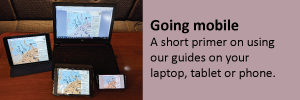Good anchors complicate your life

Sometimes old-fashioned anchors have their attraction. (Photo by Hugh Trainer)
So far, it has worked like a charm, setting quickly and securely every time we drop it regardless of that anchorage’s reputation for holding.

CQR anchor was developed in the early 1930s by British mathematician Geoffrey Ingram Taylor.
That’s the problem in a nutshell.
Anchoring is a science, but something of a science for the masses. Not everyone can rebuild their diesel engine or rewire their solar array, but everyone is an expert when it comes to anchors and anchoring.

Peter Bruce launched his new Bruce anchor design in the UK in the early 1970s.
Just go to any online marine forum and take a stand regarding hooks, chain or some obscure anchoring procedure. There will soon be replies from around the world explaining why your opinions show you to be a neophyte, dangerous to yourself and others.
We might not be in the class of the anchoring experts that hang out at the most popular Internet forums, but we anchor a lot.
In fact, we might have one of the highest DPAs in the Salish Sea. That’s Drops Per Anchorage, and yes, I made up the term.

Richard Danforth obtained a patent in 1948 for this entry into the new field of small boat anchors.
We like to report the holding at anchorages we recommend. If we can’t find resident boaters willing to share their “local knowledge” about bottom quality, we drop the hook a few times to test things for ourselves.
With any luck, the holding will be consistently good. You drop the hook, let out the rode — usually about 3:1 (depth times three) — and set it with the engine, quickly coming to a stop. Repeat once or twice nearby. Put a check mark in the box and move on. Very satisfying.
The worst anchorages are mixed. The anchor doesn’t set, dragging as you motor in reverse. Then it does set. Then it doesn’t. Not satisfying at all and I begin to regret we ever began to test anchorage holding.

The Delta anchor was developed in the 1980s by British marine manufacturer Simpson-Lawrence.
Tests for our first two guides, for the Gulf Islands and San Juan Islands, were done with a Delta anchor on our previous boat. It was a good anchor, though in soft mud and a stiff wind could drag off to discover a new world.
The next three, to Desolation Sound, Puget Sound and Georgia Strait & the Sunshine Coast, were done with a CQR that came with our new-to-us boat.

Frenchman Alain Poiraud developed the Spade anchor in the 1990s. It was a huge leap forward in performance.
Even though CQRs perform miserably in most independent anchor tests, it was good for our use. An old-fashioned anchor, CQRs hang from the bows of many boats in the Salish Sea and seem to accurately verify an anchorage’s reputation — holding is pretty much what you were led to expect.
But a few incidents, which included a scary drag in Penn Cove off Whidbey Island, prompted us to switch. Anchor tests and online experts pointed us toward one of the so-called “modern” designs with heavy, sharp flukes to cut into the bottom.

New Zealander Peter Smith in the early 2000s married elements of the Spade and others to develop the Rocna anchor.
The new anchor is good, one size bigger than our CQR, and so far has set snugly every time it was dropped, whether into sand, mud, rock or weeds.
That’s the problem. We were in a few anchorages over the summer with notorious reputations, but the anchor set securely and quickly.
So we are in a bit of a quandary as we plan to research a new guide in the spring. Do we switch back to the CQR to make observations consistent through all our guides?
Or do we qualify our observations with an asterisk, denoting “modern anchor”?
Modern anchors do complicate our lives, though there is no question we sleep better in a blow.


















